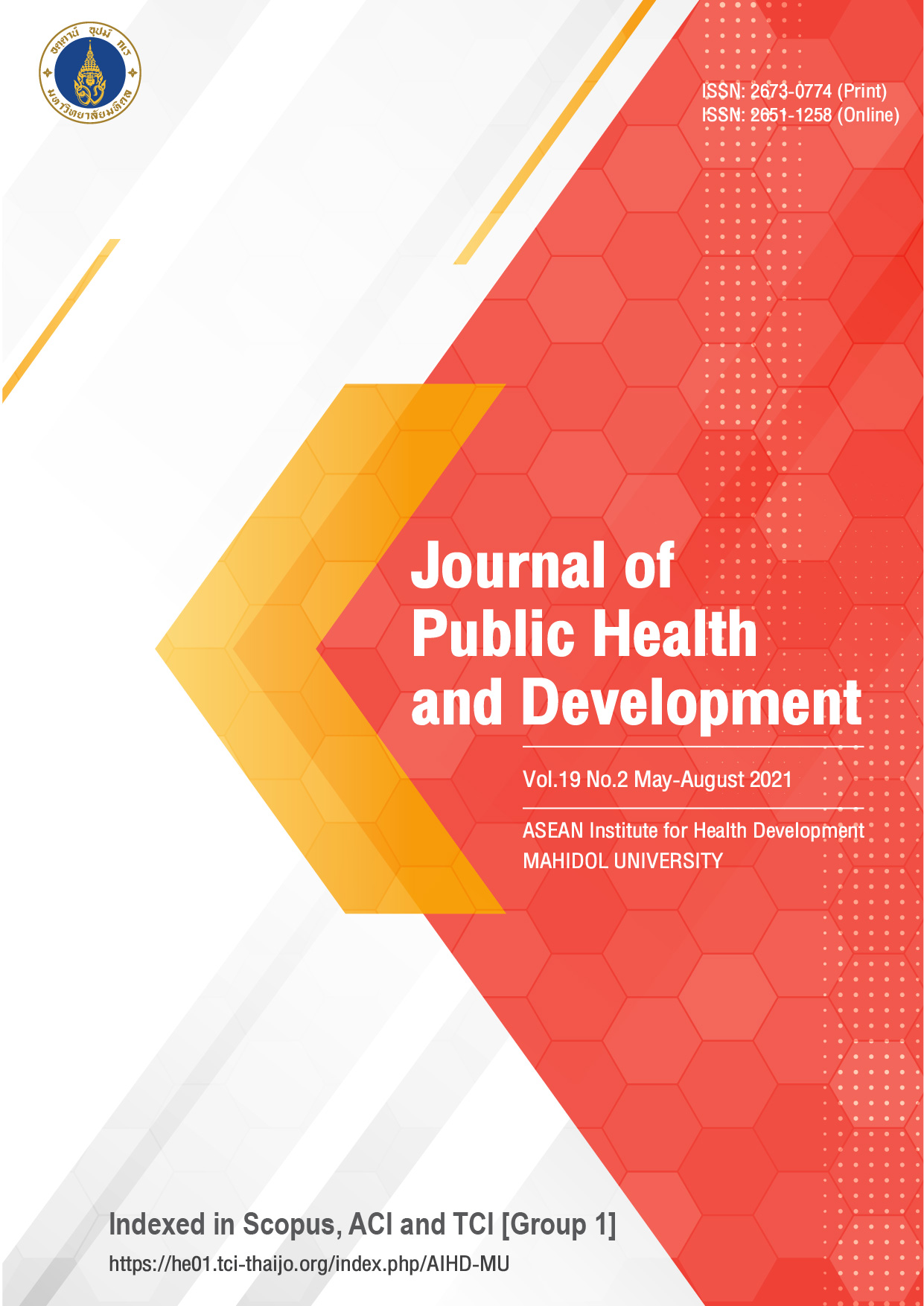Involvement in practicing family planning among married men in Kyaukpadaung Township, Mandalay Region, Myanmar -
Main Article Content
Abstract
In almost all land-bound areas over the world, men are assumed to be the most important individuals and care-givers of the family, but they are less cooperative in practicing their family planning especially regarding contraception use and antenatal care of their wives than in conducting other socio-economic activities. Traditionally, family planning has been mainly focused on women, and most of the methods are designed for women considering that it is the women who become pregnant and delivering reproductive health services as part of maternal and child health programs is convenient. The study aimed to investigate the proportion of male involvement in family planning and factors associated with male intention to be involved in family planning. Cross-sectional survey research was conducted among 388 married men, using systematic random sampling. The data were collected using questionnaire interviews during March and April 2019 and analyzed by frequency, percentage, Chi-square test, and multiple logistic regressions. The proportion of male involvement in families practicing family planning was 40.7%, condom being the most commonly used method. The factors influencing the practice of family planning included attitude towards family planning, subjective norm and intention to be involved. By following the Theory of Planned Behavior model, the variables such as attitude, subjective norm and intention were significantly associated with male involvement in family planning (P-value < 0.05). Respondents with positive attitudes were 2.12 times more likely to use family planning than those with negative attitudes. (ORAdj = 2.12, 95% confidence interval (CI) = 1.13-2.87, P-value 0.024). Regarding subjective norms, respondents with positive subjective norms were 2.11 times more likely to use family planning than those with negative subjective norms (ORAdj = 2.11, 95% CI = 1.25-3.25, P-value 0.011). Moreover, respondents who had good intention were 8.12 times more likely to use family planning than those with poor intention (ORAdj = 8.12, 95% CI = (4.71-13.82, P-value 0.001). The results suggested that effective education programs focusing on improving the knowledge of family planning, gaining a better attitude, complying with good subjective norms as well as reaching high perceived behavior control and good intention should be implemented to improve male involvement in practicing family planning.
Article Details

This work is licensed under a Creative Commons Attribution-NonCommercial-NoDerivatives 4.0 International License.
References
Jayalakshmi, M.S. et al. A study of male involvement in family planning. Health and Population-Perspectives and Issues 2014.
Mbizvo M.T. and Adamchak D.J. Family planning knowledge, attitudes and practices of men in Zimbabwe. Study Family Planning 2015.
Ezeh A.C., Seroussi M. and Raggers H. 'Men’s fertility, contraceptive use and reproductive preference. Demographic and Health Surveys. 2014.
Oyediran K.A., Ishola G.P. and Feyisetan B.J. Factors affecting ever-married men’s contraceptive knowledge and use in Nigeria. J Biosoc Sci 2015; 34(4):490-510.
Mistik S, Married men’s opinions and involvement regarding family planning in rural areas. Contraception 2003; 67(2):133-7.
Vouking M.Z., Evina C.D. and Tadenfok C.N. Male involvement in family planning decision making in sub-Saharan Africa- what the evidence suggests. Pan Afr Med J 2014;3:19:349.
Char, A Male Involvement in Family Planning and Reproductive Health in Rural Central India [Internet]. [cited 2018]. Available from: https://tampub. uta.fi/bitstream/ handle/ 10024/66834/ 978-951-44-8658-6.pdf
Bougangue B, Ling HK. Male involvement in maternal healthcare through Community- based Health Planning and Services: the views of the men in rural Ghana. BMC Public Health 2017;17(1):693.
DaVanzo J, Adamson DM. Family planning in developing countries: an unfinished success story [Internet]. 2015. Available from: https://www.rand.org/ pubs/issue_papers/IP176.html
Gupta DN. The Importance of family planning and birth control [Internet]. 2015 [cited 2015 May 11]. Available from: http://www.indiatimes.com/health/ healthyliving/the-importance-of-family-planning-and-birth-control-242747.html.
Organization World Health WH. South East Asian Regional Office [SEARO]: Myanmar and Birth Spacing: An Overview. Retrieved 2015.
Myanmar population and housing census, the Republic of Union of Myanmar, Mandalay Division, Nay Pyi Taw 2014; 48.
Ampt F, Mon MM, Than KK, Khin MM, Agius PA, Morgan C, et al. Correlates of male involvement in maternal and newborn health: a cross-sectional study of men in a peri-urban region of Myanmar. BMC Pregnancy & Childbirth 2015;15 (1):1.
Zemore SE, Ajzen I. Predicting substance abuse treatment completion using a new scale based on the theory of planned behavior. Journal of Substance Abuse and Treatment 2014;46(2):174-82.
Bloom Bengamin S, Mesia Bertram B, Krathwohl David R. Taxonomy of Educational Objectives (two vols: The Affective Domain & The Cognitive Domain). New York. 1964.
David W.Hosmer. Applied Logistic Regression. Second edition. A Wiley Inter science Publication, New York. University of Massachusetts. 2000.
Htet H. Male involvement in family planning practice among Myanmar migrant living in Bang KhunThian District, Bangkok, Thailand: Mahidol University. 2011.
Pradesh U. Male involvement in family planning: a case study spanning five generations of a South Indian family [Internet]. 2015. Available from: https://pubmed.ncbi.nlm.nih.gov /9097383/
Balaiah D, Naik D, Parida R, Ghule M, Hazari K, Juneja H. Contraceptive knowledge, attitude and practices of men in rural Maharashtra. Advances in contraception 2014;15(3):217-34.
Mistik S, Nacar M, Mazicioğlu M, Cetinkaya F. Married men’s opinions and involvement regarding family planning in rural areas. Contraception 2015;67(2): 133-7.
Lwin K. Factors influencing HIV/AIDS preventive behavior among young Myanmar male workers in Samut Sakhon Province, Thailand. Bangkok: Mahidol University. 2014.
Benner MT, Townsend J, Kaloi W, Htwe K, Naranichakul N, Hunnangkul S, et al. Reproductive health and quality of life of young Burmese refugees in Thailand. Confl. Health 2012;4(1):5.
Martian_Cupid CE. The practice of contraception among the Thai Muslim and Thai Buddhist in the south of Thailand [Internet]. 2016. Available from: https://content.sciendo.com/ view/journals/abm/10/4/article-p351.xml?language=en
Mosiur R, Rafiqul I, Matin A. Male contraceptive behavior in Rajshahi District of Bangladesh. Int. Med J Malays. 2014;7(2).
Withers M, Kano M, Pinatih GNI. Desire for more children, contraceptive use and unmet needs for family planning in a remote area of Bali, Indonesia. J. Biosoc. Sci 2013;42(04):549-62.


